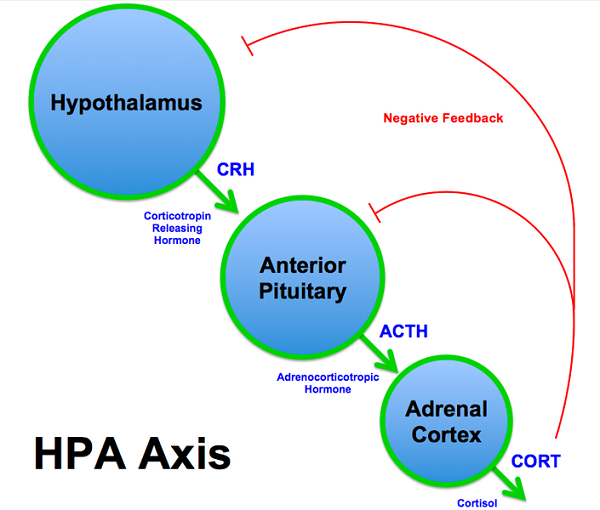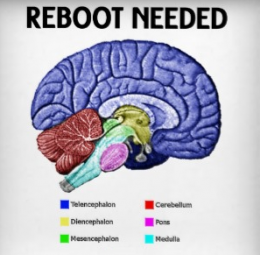If you are anywhere like me, you must have days that feel like the software in your mind is glitching so bad you just want to stick that head in the freezer or drink yourself to death just to enjoy a moment of peace. It can seem like no matter how hard you try to control yourself you keep over-reacting, and bursting out over the most trivial things.
Don’t know about you but I have days when even my cat’s purr irritates the hell out of me. Its as if someone starts a Harley Davidson in the middle of Yosemite Park.
When irritation strikes, what may seem, out of nowhere, I listen to it because I know this is the phase when my emotional intelligence just took a shot of vodka. Being an interesting phenomenon, it made me dig for answers. I wanted to know the bio-mechanics behind irritability so that I can “fix it”.
What I found out was that irritability is closely related to anxiety, and it all works through our body’s, so called, HPA Axis. The cool part about is that once we have the mechanics behind the HPA Axis function we can control it better.
Now, I am not a big fan of brain hacks. Mainly because trying to trick the brain is like trying to fix a radio when it’s the signal quality that is the real culprit behind the poor sound quality. However, I feel our HPA axis is a bit different in this respect. There are times when our brain simply needs a good reboot in order to stabilize our mind and spirit.
By learning to work with the biochemistry of our HPA axis we can learn to slow down our knee jerk reactions and bring ourselves back into a more relaxed state of mind. This simplified “How” is what I’d like to share with you here.
Background
It is safe to say that pretty much everyone in my family is pretty intense on all levels. I never realized this till I moved out of town and had to live with other people in college. Only then I realized how sensitive and irritable I could be. My other side however, is very happy, blissful and content. But because I am so intense, emotionally, I could achieve the highest highs and lowest lows.
Today, I can attest that with natural maturity and years of reading and practice emotions can stabilize and it gets easier to keep my inner equilibrium. One thing that hasn’t changed that much however is the irritability. That sneaky bugger still creeps up on me and never seizes to amaze.
Definition of Irritability (physiology) – The ability of the cell to receive and respond to a stimulus; (pathology) – The excessive sensitivity of a bodily organ or part to a stimulus; undue susceptibility to the influence of a stimulus.
Let’s face it, when we’re irritable, it makes managing our negative emotions seem almost impossible. We over-react more and snap quicker. I don’t know about you but those days I just try to go into damage control and stay under the radar.
When I first read about HPA Axis things immediately made sense, because I could substantiate the science behind it with years of personal observation. I was also somewhat relieved to find out that our varied sensitivity (of the HPA axis) in handling life stressors is determined through genetics. It looks like some people inherit a more “delicate” temperament and therefore are more prone to irritability, anxiety, and as a result – anger. Heck, you and I could be some of those unfortunate ones but don’t despair amigo – there is hope. Let’s dive into it.
What is HPA Axis
The hypothalamic-pituitary-adrenal axis (HPA), is a mind numbingly complex set of influences and feedback interactions among three endocrine glands. It is comprised of three parts of our body:
1) Hypothalamus (part of your fore-brain);
2) Pituitary gland (just below the hypothalamus);
3) Adrenal glands (at the top of the kidneys).
All three parts work in unison to regulate functions such as stress response, mood, digestion, immune system, libido, metabolism and energy levels. Thanks goodness we don’t don’t have to know how, it just happens!

HPA Axis Chemistry
1. Corticotropin-Releasing Hormone (CRH) – is produced and secreted by the hypothalamus in response to either physical or psychological stress resulting from diet, lifestyle, work, etc. CRH is further transported to your pituitary gland to secrete Adrenocorticotropic Hormone (ACTH).
2. Adrenocorticotropic Hormone (ACTH) – once released by the pituitary gland ACTH shoots to your kidneys and stimulates the adrenal glands to increase production of Glucocorticoids.
3. Glucocorticoids – are steroids that regulate a variety of things in the human body. One of the most famous of them is Cortisol.
4. Cortisol – plays a role in regulating our blood pressure, insulin, metabolism, and activates our physical response to stress, injury, sleep deprivation, physical exhaustion, anxiety, and many others. Like anything else in our body, small increases of this vital hormone bears positive effects such as protecting our body organs from stressful events in our life, provides for increased energy, physical and mental performance, better memory, etc. However, a prolonged exposure to high cortisol levels have the exact opposite effect.
To keep the system in balance, our bodily intelligence activates a negative feedback system. This means that high levels of cortisol trigger the hypothalamus to reduce its output of CRH which in turn lowers the levels of ACTH and cortisol.

In low-stress individuals (good luck finding these in the Western societies) this entire HPA axis feedback loop works in harmony. All is nice and dandy until something interrupts this cycle or doesn’t shut it off and we start living in a perpetual state of anxiety and irritability.
One of the ways this can happen is when due to perpetual crises in our lives cortisol becomes so chronically overproduced that the entire HPA axis eventually becomes desensitized to the negative feedback telling it to “calm down.” This leads to chronic stress on the hypothalamus, pituitary gland and adrenal glands.
In scientific terms, when we are chronically anxious or stressed, and we don’t give the body time to reset itself back to a balanced state, we might get stuck in sympathetic nervous system arousal mode. In short, our brain scans start looking like this:

Recent research has blamed hyperactivity of the sympathetic nervous system to chronic illnesses such as multiple sclerosis, poliomyelitis, chronic fatigue, fibromyalgia, let alone its contribution to irritability and anger.
Now, there is good and news we don’t want to hear. The good news is that it is possible to reset and keep the HPA Axis balance in check but the news that we do not want to hear is that there is no pill for it. This means it will require effort, new habits and some changes in your routine.
Like with anything in life that produces any meaningful results, the solution will require a multifaceted approach. What works for me is when I target the problem from a number of different directions but most importantly at the source of it all.
In the Part 2 of this article (see below link) I will explain in detail some of the things you can do to tone down anxiety and irritability. I’ll show you the exact steps I took to balance the HPA Axis, and fine tune my emotional health.
Part 2: Ways to Reset Your HPA Axis & Dramatically Improve Emotional Health.


 Is Your Anger a Sign of Power or Weakness?
Is Your Anger a Sign of Power or Weakness? 5 Uncommon Rules for Fighting Fair and Winning, Every Single Time
5 Uncommon Rules for Fighting Fair and Winning, Every Single Time Can Anger Really Make You Sick as a Dog?
Can Anger Really Make You Sick as a Dog?